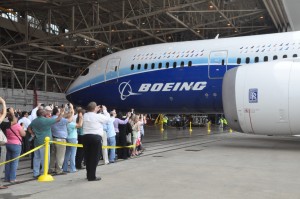Dreamliner Under Scrutiny: Teething Problems or Sign of Things to Come?
Boeing and its launch partners for the 787 Dreamliner aircraft, which include All Nippon Airways, Japan Airlines, United Airlines, and LOT Polish Airlines, had been planning the new airplane’s debut for years and hoped for lots of publicity. One year later, the Dreamliner is continuing to garner headlines, but not necessarily the kind these companies had hoped for.
Earlier today, ANA had to cancel a domestic Dreamliner flight destined for Tokyo’s Haneda Airport when an onboard computer malfunctioned and reported a brake problem.
On Tuesday, a Japan Airlines-operated Dreamliner returned to the gate at Boston’s Logan Airport after discovering a fuel leak and, on Monday, an electrical fire broke out in the belly of another JAL Dreamliner, also at Logan. The leak was quickly fixed and the aircraft took off later the same day but the fire, apparently caused a battery attached to the APU or auxiliary power unit. The Wall Street Journal later reported that United Airlines, the launch customer for the Dreamliner in the United States, had found a similar problem with the APU in one of its six aircraft. A United Airlines representative would not confirm this, however.
The National Transportation Safety Board has launched an investigation into the JAL electrical fire and said that the APU’s battery had “severe fire damage.”
The new wiring problems, however, seem to be unrelated to recent reports of electrical issues on the Dreamliner. Last month, the FAA ordered mandatory inspections of 787 aircraft after concerns were voiced about fuel line leaks and improperly assembled engine attachments.
The first Dreamliner (operated by launch customer ANA) took flight in late 2011. Boeing has delivered over 50 Dreamliners since the launch. Boeing is in the process of doubling its production rate and plans to deliver ten Dreamliners per month by the end of 2013.
On Tuesday, Boeing released a statement saying that it could not find a relationship between this week’s battery problem and previous issues with the Dreamliner’s power systems, which involved faults in power panels in another part of the electrical equipment bay.
“Boeing is cooperating with the N.T.S.B. in the investigation of this incident,” the company said. “Before providing more detail, we will give our technical teams the time they need to do a thorough job and ensure we are dealing with facts, not speculation.
In December, Boeing CEO James McNermey was interviewed on CNBC’s Squawkbox program and said that the airline regrets the impact of the Dreamliner’s problems on its customers. “We’re having what we would consider the normal number of squawks on a new airplane, consistent with other new airplanes we’ve introduced.” McNermey went on to say that the number of problems was consistent with what the aircraft manufacturer experienced in the 1990s after introducing the Boeing 777.
“This is an issue we’re chasing down,” McNermey concluded. “We’re investigating it right now.”
Because the electrical system on the Dreamliner aircraft plays a much more significant and key role than on earlier aircraft, any malfunctions of the system require far greater scrutiny. The design of the Dreamliner includes an electrical system that powers the cabin environmental system, deices the wings, and starts the engines. Previously, these functions were powered by a system that used hot air from the engines as a power source.
Some customers remained unconcerned. “There will be small teething problems from time to time, but this is foreseen with any new aircraft program,” Qatar Airways CEO Akbar Al Baker told a group of reporters earlier today. Qatar’s maiden commercial 787 flight is scheduled for today.






